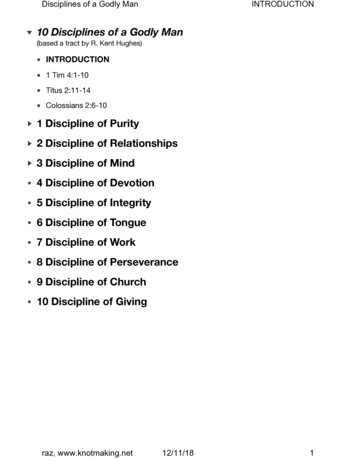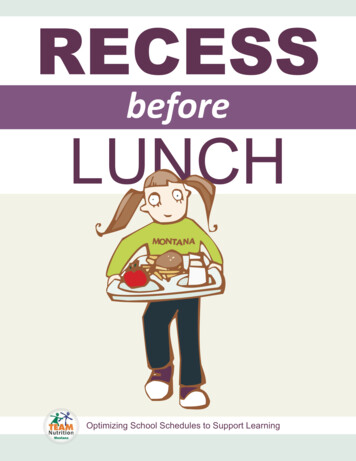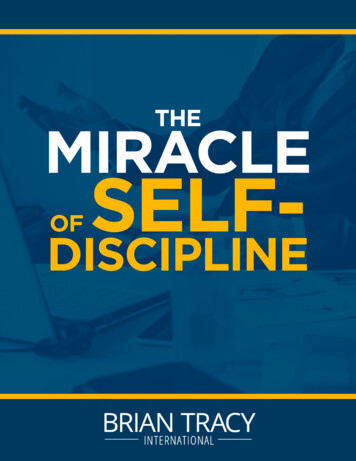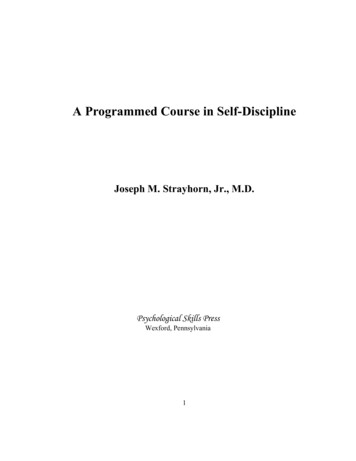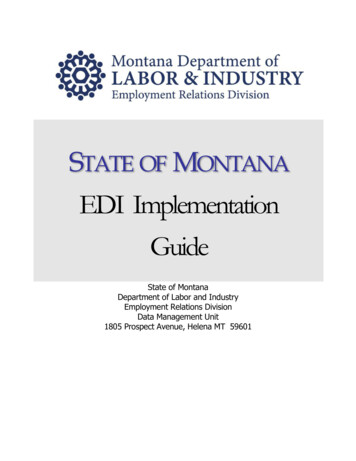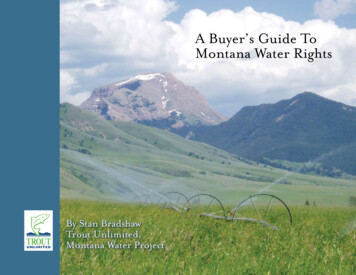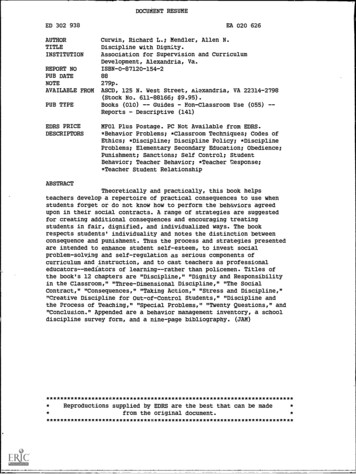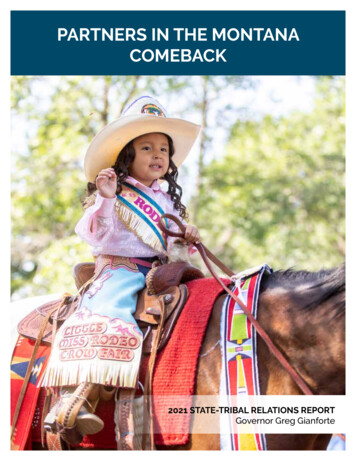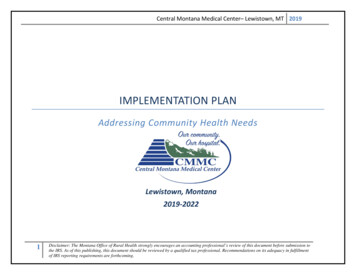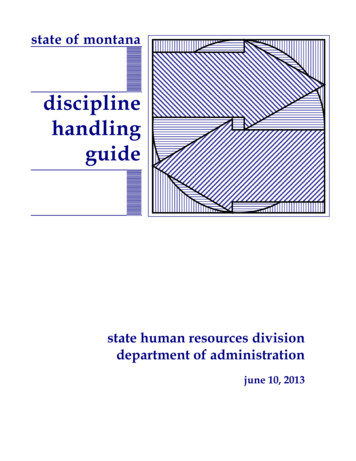
Transcription
state of montanadisciplinehandlingguidestate human resources divisiondepartment of administrationjune 10, 20131
STATE OF MONTANADiscipline Handling Guidecontentsc o n c e p t sdiscipline and effective supervisionwhat is discipline? . . . . . . . . . . . . . . . . . . . . . . . . . . . . . . . . . . . . . . . . . . . . . . . . . . .what are my supervisory responsibilities? . . . . . . . . . . . . . . . . . . . . . . . . . . . . . . . . .how do these relate to supervisory practices? . . . . . . . . . . . . . . . . . . . . . . . . . . . . . . .how should I deal with problems? . . . . . . . . . . . . . . . . . . . . . . . . . . . . . . . .1122progressive disciplinewhat is progressive discipline? . . . . . . . . . . . . . . . . . . . . . . . . . . . . . . . . . . . . . . . . . . .what are the progressive discipline steps? . . . . . . . . . . . . . . . . . . . . . . . . . . . . . . . . . .what about employee assistance? . . . . . . . . . . . . . . . . . . . . . . . . . . . . . . . . . . . . . . . . .333critical concepts of disciplinehow has the employment environment changed? . . . . . . . . . . . . . . . . . . . . . . . . . . . . .4what is just cause? . . . . . . . . . . . . . . . . . . . . . . . . . . . . . . . . . . . . . . . . . . . . . . . . . . . . . 4what is due process? . . . . . . . . . . . . . . . . . . . . . . . . . . . . . . . . . . . . . . . . . . . . . . . . . . .6what about due process rights before discipline? . . . . . . . . . . . . . . . . . . . . . . . . . . . . .6what does an investigation involve? . . . . . . . . . . . . . . . . . . . . . . . . . . . . . . . . . . . . . . .8what about documentation? . . . . . . . . . . . . . . . . . . . . . . . . . . . . . . . . . . . . . . . . . . . . .8what are informal documents? . . . . . . . . . . . . . . . . . . . . . . . . . . . . . . . . . . . . . . . . . . .8what are formal documents? . . . . . . . . . . . . . . . . . . . . . . . . . . . . . . . . . . . . . . . . . . . .9how do informal documents relate to formal documents? . . . . . . . . . . . . . . . . . . . . .10a note about confidentiality. . . . . . . . . . . . . . . . . . . . . . . . . . . . . . . . . . . . . . . . . . . . . .11p r o c e d u r e sinformal disciplinary actionswhy use informal disciplinary actions? . . . . . . . . . . . . . . . . . . . . . . . . . . . . . . . . . . . . . 12coaching . . . . . . . . . . . . . . . . . . . . . . . . . . . . . . . . . . . . . . . . . . . . . . . . . . . . . . . . . . . . . 12oral warning . . . . . . . . . . . . . . . . . . . . . . . . . . . . . . . . . . . . . . . . . . . . . . . . . . . . . . . . . . 13formal disciplinary actionswhat are formal disciplinary actions? . . . . . . . . . . . . . . . . . . . . . . . . . . . . . . . . . . . . . .written warning . . . . . . . . . . . . . . . . . . . . . . . . . . . . . . . . . . . . . . . . . . . . . . . . . . . . . . .example of written warning . . . . . . . . . . . . . . . . . . . . . . . . . . . . . . . . . . . . . . . . . . . . . .suspension without pay . . . . . . . . . . . . . . . . . . . . . . . . . . . . . . . . . . . . . . . . . . . . . . . . .exempt employees and suspension without pay . . . . . . . . . . . . . . . . . . . . . . . . . . . . . . .administrative leave . . . . . . . . . . . . . . . . . . . . . . . . . . . . . . . . . . . . . . . . . . . . . . . . . . . .i2141415161717
p r o c e d u r e s(continued)disciplinary demotion . . . . . . . . . . . . . . . . . . . . . . . . . . . . . . . . . . . . . . . . . . . . . . . . . . .example of suspension without pay notice . . . . . . . . . . . . . . . . . . . . . . . . . . . . . . . . . . .example of a disciplinary demotion notice. . . . . . . . . . . . . . . . . . . . . . . . . . . . . . . . . . . .discharge . . . . . . . . . . . . . . . . . . . . . . . . . . . . . . . . . . . . . . . . . . . . . . . . . . . . . . . . . . . .example of discharge letter . . . . . . . . . . . . . . . . . . . . . . . . . . . . . . . . . . . . . . . . . . . . . .the wrongful discharge from employment act . . . . . . . . . . . . . . . . . . . . . . . . . . . . . . . .181920212223conducting disciplinary meetingswhat is the purpose of a disciplinary meeting? . . . . . . . . . . . . . . . . . . . . . . . . . . . . . . .how do I prepare for a meeting? . . . . . . . . . . . . . . . . . . . . . . . . . . . . . . . . . . . . . . . . . .any additional preparation pointers? . . . . . . . . . . . . . . . . . . . . . . . . . . . . . . . . . . . . . . .what about the meeting itself? . . . . . . . . . . . . . . . . . . . . . . . . . . . . . . . . . . . . . . . . . . . .what does “Weingarten” mean? . . . . . . . . . . . . . . . . . . . . . . . . . . . . . . . . . . . . . . . . . . .2424252626employee assistancewhat is employee assistance? . . . . . . . . . . . . . . . . . . . . . . . . . . . . . . . . . . . . . . . . . . . .what do you mean by “personal problems”? . . . . . . . . . . . . . . . . . . . . . . . . . . . . . . . .how do I approach employee assistance? . . . . . . . . . . . . . . . . . . . . . . . . . . . . . . . . . . .what should I do? . . . . . . . . . . . . . . . . . . . . . . . . . . . . . . . . . . . . . . . . . . . . . . . . . . . . .what should I avoid? . . . . . . . . . . . . . . . . . . . . . . . . . . . . . . . . . . . . . . . . . . . . . . . . . . .2828293030a final word . . . . . . . . . . . . . . . . . . . . . . . . . . . . . . . . . . . . . . . . . . . . . . . . . . . . . . . . . . . . 31appendixfull text: wrongful discharge from employment act . . . . . . . . . . . . . . . . . . . . . . . . . . .coaching form . . . . . . . . . . . . . . . . . . . . . . . . . . . . . . . . . . . . . . . . . . . . . . . . . . . . . . . .written warning form . . . . . . . . . . . . . . . . . . . . . . . . . . . . . . . . . . . . . . . . . . . . . . . . . . .suspension form . . . . . . . . . . . . . . . . . . . . . . . . . . . . . . . . . . . . . . . . . . . . . . . . . . . . . . .This guide provides assistance tostate supervisors and managers in administeringdisciplinary action. This guide is not state policyor administrative rule. It is not binding on any agency;it does not establish practice or set precedent.ii333353637
discipline and effective supervisionwhat isdiscipline?Discipline is asystem ofcommunication –about expectationsand, when necessary, about expectedchanges in behavior“Discipline” represents perhapsthe most difficult area of supervision. In part, this difficulty stemsfrom the many meanings peopleplace on the word itself .control, orderliness, and efficiency. When necessary, it includessupervisory actions that correctemployee behavior. Although asupervisor may sometimes needto penalize employee behavior,that aspect of discipline must besecondary; it should be used onlywhen necessary.dis ci pline n. [ME. OFr. descepline L. disciplina discipulus: seeDISCIPLE] 1. a branch of knowledge orlearning 2. a) training that developsself-control, character, or orderlinessand efficiency b) strict control to enforce obedience 3. the result of suchtraining or control; specif., a) selfcontrol or orderly conduct b) acceptanceof or submission to authority and control4. a system of rules, as for the conductof members of a monastic order 5.treatment that corrects or punishesThis guide will help you in yourjob as a supervisor in a stateagency. As you read this guide,keep in mind that preventive action — establishing and maintaining good “discipline” in yourunit — is preferable to takingdisciplinary action.(Webster's New World Dictionary)what are mysupervisoryresponsibilities?In our approach to discipline, wewill emphasize its definition astraining that develops self-Remember, effective discipline ismore prevention than interven-As a supervisor, you are responsible for developing and maintaining a high level of performance in your work unit. Youare also responsible for developing and maintaining appropriateconduct and good working relationships in your unit.These include . . .tion. the agency's policies, rules, andregulations governing the employees' work, the proper kind of behavior expected of employees to establish and maintain good working relationships,In your responsibilities as a supervisor, you need to be aware ofthings employees must know toperform their jobs efficiently. the objectives, duties, andtasks each employee is expected to perform.1
what are mysupervisoryresponsibilities?(continued)how do theserelate tosupervisorypractices?how should I dealwith problems?The occurrence of aproblem does notreflect on your abilityas a supervisor; howyou handle it does what you, as the supervisor,consider the standards of performance for the job, how well each employee ismeeting those expected standards of performance, knowing the scope of your authority to impose or recommend disciplinary action, how the employees can improve their performance andworking capabilities.It is essential that, with yourhelp, employees learn and practice constructive behavior patterns in their work. Good working habits will have a “ripple effect,” influencing the behavior ofevery employee in the unit.Good supervisory practice requires that you keep maintaindocumentation on performanceand conduct. This enables you tojustify decisions you make concerning performance appraisaland disciplinary action.Set reasonable work objectives foryour employees. A key point is toset objectives that are reasonableboth to you and your employees.Employee participation in settingobjectives can result in realisticgoals that employees are committed to achieving.Good supervisory practice requires that you be willing tomake such decisions promptly,impartially, and with justification. If an employee exhibits unacceptable conduct or performance, intervene as soon as practical.No matter how good a supervisoryou are, problems will occasionally arise in your work group. Theoccurrence of a problem does notreflect on your ability as a supervisor; how you handle it does.thority, make sure you refer it tothe proper person, such as yoursupervisor or the human resources officer. Make sure theemployee knows the outcome ofyour discussion with the otherperson.You should encourage and helpthe employee to solve the problem.Many situations that have the potential to develop into chronicproblems can be resolved by thesupervisor properly communicating with the employee.If you supervise members of abargaining unit, be sure you arefamiliar with the terms of the union contract before acting or recommending any action.Often, simple courtesy, straightforward discussion, and “clearingthe air” can prevent minor problems from growing into grievanceactions. A later section of thisguide provides tips on conductingmeetings with employees.If the solution to the problemwith the employee is within thescope of your responsibility, examine the situation and try tocorrect the problem. If the problem is above or beyond your au2
progressive disciplinewhat isprogressivediscipline?Progressive discipline is a processof applying disciplinary actions,moving from less serious to moreserious actions based on the initial severity or on repetition ofthe problem behavior.are very serious. These problemsmerit disciplinary action that begins at a higher level than stepone. To determine which actionto take, you must consider . . . past treatment of similarproblems the proper kind of behaviorexpected of employees to establish and maintain goodworking relationships, the offense and its effects the relevant policy the circumstances the employeeFor most conduct problems, discipline begins at the first of theseactions. Any later occurrences ofthe same problem by the sameemployee require more seriousdisciplinary action.Some infractions — such as theft,assault, or falsifying records —what are theprogressivediscipline steps?The State's discipline-handlingpolicy lists these actions:disciplinary interventions may bepossible.Informal disciplinary actions1. coaching2. oral warningManagement must decide whichstep of the progressive disciplineprocess is best in a given situation. You also must determinethe specific actions to take andthe order of these actions.Formal disciplinary actions3. written warning4. suspension without pay5. disciplinary demotion6. dischargewhat aboutemployeeassistance?The policy also allows that otherFailing to follow your agency'spolicies on progressive disciplinemay expose the State and theagency to legal liability.Employee assistance can be helpful at any stage of progressive discipline– for both employee andsupervisor. You can find more information about employee assis-tance later in this guide. In addition, information on employee assistance is available from theHealth Care and Benefits Division,Department of Administration.3
critical concepts of disciplinehow has theemploymentenvironmentchanged?Time was, not so long ago, employers enjoyed nearly unlimitedpower to discipline and dischargeemployees. Over the last severalyears, however, this arbitrarypower has been limited by statutes and court decisions.tions, such as discharge. Andmost public employers, such asthe state, must afford due processto the affected employee.The next couple of sections explain what these concepts meanfor state supervisors.Some important cases have dealtwith specific issues, such as discrimination and workers' compensation. More importantly, agrowing number of court decisions have outlined the employer's responsibility to show justcause for severe disciplinary ac-what is justcause?“Just cause” meansreasonable, jobrelated grounds fortaking disciplinaryactionMontana's Wrongful Dischargefrom Employment Act sets outcertain rights and remedies withrespect to wrongful discharge.You can read a description of thislaw later in this guide and its fulltext in the appendix.The term “just cause” — alsocalled “good cause” or simply“cause” — eludes precise definition. Courts and arbitrators havewrestled with the term, trying topin a workable meaning on it.For our purposes, the state's discipline-handling rules define “justcause”: reasonable, job-related grounds fortaking a disciplinary action based onfailure to satisfactorily perform job duties, or disruption of agency operations.In 1987, the Montana Legislaturepassed the Wrongful Dischargefrom Employment Act. For thepurposes of the law, it defines“good cause”:the definition continues Just cause may include, but is not limited to: an actual violation of an established agency standard, procedure, legitimate order, policy, or labor agreement; failure to meet applicable professional standards; criminal misconduct; wrongful discrimination; deliberate misconduct; negligence; deliberately providing false information onan employment application; willfuldamage to public or private property;workplace violence or intimidation;harassment; unprofessional or inappropriate behavior; or a series of lesserviolations. reasonable job-related grounds fordismissal based on a failure to satisfactorily perform job duties, disruption of the employer's operation, orother legitimate business reason.The legal use of a lawful product byan individual off the employer'spremises during nonworking hours isnot a legitimate business reason, unless the employer acts within theprovisions of 39-2-313(3) or (4).4
what is justcause?(continued)Essentially, to showjust cause,management must1) show that theemployee violated aspecific policy, rule,performancerequirement, orstandard ofemploymentand2) show that theemployee knewabout the policy,rule, performancerequirement, orstandard ofemployment You’re not required to provideevidence that is “beyond a reasonable doubt,” but it must bereasonable and clear.The key words in this definitionare reasonable and job-related.As you consider whether to takedisciplinary action, you need toconsider a number of factors todetermine if just cause is present.The following seven questions canhelp you determine whetheryou’ve established just cause.6. Has the employer applied itsrules, orders, and penaltieseven-handedly and withoutdiscrimination among all employees?1. Did the employee's alleged behavior violate a specific workrule, policy, or managerial order? If not, the apparent or real discrimination may result in theoverturning or modification of adisciplinary action. If the employer has been lax inenforcing rules and policies anddecides to “get tough,” it shouldnotify employees beforehand ofits intent to enforce all rulesand policies as written.2. Did the employer give the employee forewarning of the possible or probable consequencesof the employee's conduct? written policies orientation and training verbal and written warnings7. Was the degree of disciplineadministered in a particularcase reasonably related to a)the seriousness of the employee's offense, and b) the employee's record of service?3. Was the rule or managerial order that the employee violatedreasonably related to the orderly, safe, and efficient operationof the agency? A trivial offense does not meritharsh discipline unless the employee has committed the sameoffense a number of times inthe past. Management should refer tothe employee's “record of service” only to determine the severity of discipline. If two or more employees commit the same offense, their respective records provide the only proper basis for “discriminating” between them in administering discipline.4. Did management, before administering discipline to anemployee, make an effort todiscover whether the employeedid, in fact, violate a rule or order? The investigation should normally occur prior to any disciplinary decision.5. Was the investigation conducted fairly and objectively?Keep in mind that the state's discipline-handling rules requiremanagement to have just causefor taking any formal disciplinaryaction. The employer must make areasonable, “good faith” effortto discover all the facts about agiven case.5
what is dueprocess?The state’s grievanceprocedure – properlyfollowed – satisfiesthe due processrequirement, exceptin cases wheredue process is necessary before disciplinary decisionsThe opportunity togrieve a formal disciplinary action doesnot apply when theaction is a writtenwarningBe aware of anygrievance procedurethat’s included in anapplicable collectivebargainingagreementwhat about dueprocess rightsbefore discipline?The U.S. Constitution (Fourteenth Amendment) and theMontana Constitution (Article II,Section 17) state that the government shall not deprive a person of property or liberty withoutdue process of law. Statutes oradministrative rules may givepublic employees a “property interest” in continuing their employment with an agency.Critical elements of this noticeinclude:1. the just cause (reasons) for thedisciplinary action,2. a description of the disciplinaryaction, including dates and duration, if applicable,3. the improvements or corrections expected of the employee,if applicable,If a public employee has a “property interest” in his or her position, the agency may not deprivethe employee of that interest(that is, impose an economic detriment) without “due process oflaw.” The governmental agencymust determine what process is“due” in a given case.4. consequences (further discipline) if the employee fails toimprove or correct behavior, ifapplicable, and5. the employee's right to respond, either orally or in writing.Management must present thewritten notice to the employee forhis or her review. If the employeechooses not to sign the notice, youmay note that fact on the notice.You might have a witness to therefusal sign the notice in thepresence of you and the employee.Preferably, the witness will be anagency human resources officeror your boss.In general, due process requiresthat the employee receive noticeof and an opportunity to respondto formal disciplinary action.Under the state's disciplinehandling rules (ARM 2.21.6507),this requirement means . . . an employee:1. is informed of the action being taken and the reason for the action; and2. has the opportunity to respond.To ensure that due process isprovided, the state's rules requirethat formal disciplinary action include written notification to theemployee.Any written response by the employee must be attached to thenotice and included in the employee's personnel file. The employee may also grieve certainformal disciplinary actions.The state's discipline-handlingpolicy requires that an employeefacing formal disciplinary actionreceive written notice and an opportunity to respond. The state'sgrievance policy also provides theopportunity for a hearing afterdischarge.In particular, the U.S. SupremeCourt decided Loudermill v.Cleveland Board of Education inMarch 1985. This case yieldedguidelines for a hearing before apossible discharge.In October 1994, the MontanaSupreme Court decided Boreen v.Christensen. The Court held thatthe state's discipline policy creates a property interest for per-Court cases have affected dueprocess rights for permanentstate employees facing discharge.6
what about dueprocess rightsbefore discipline?(continued)A neutral third partymay hear theemployee’s side ofthe story and investigate the situationbefore the decisionis made whether tosuspend, demote, ordischarge theemployeemanent state employees. Thisproperty interest gives rise to theright of due process before deciding on discipline that could havean economic impact on the employee (such as demotion, suspension without pay, or discharge).ing; an informal process works.As an alternative, the employeemay submit a written response tothe information. To be effective, the person conducting the review should bewell versed in the legal principles governing employee discipline, as well as the state'shuman resource policies andpractices.Under the impact of these cases,you should consider the followingsuggestions that would satisfythe need for a “due-process meeting” or “Loudermill hearing.” The due-process review orhearing need not resolve definitely the issue of discipline;the review is an initial checkagainst mistaken decisions. Itspurpose is to determine if thereare reasonable grounds to believe that the charges againstthe employee are true and support the proposed discipline. Never fire an employee “onthe-spot.” Allow a “cooling-off”period before making a decision on discharge. If it is vitalto remove the employee fromthe work situation, place theemployee on administrativeleave, pending the outcome. Remember that “Weingartenrights” apply for union employees. See the section starting onpage 26. A due-process review may takeplace to determine if there arereasonable grounds to believethe allegations against the employee are true and that the evidence supports the disciplinary decision.A due processmeeting prior todiscipline isinformal – there isno requirement tointroduce evidenceor to examinewitnesses Thorough due process requiresgood documentation:a. Date and time of the meeting,names of those attending;b. List of the allegations about theemployee’s conduct or performance;c. The employee’s response, alongwith any other discussion;d. Any evidence presented by theemployee in the meeting;e. Review of relevant policies;f. Information, if available, on howthe agency has addressed similarissues in the past;g. A review of the employee’s history,if not already in the investigationreport. The person conducting the review should be someone whohas not been involved in recommending the employee' discharge. Preferably, the personwould not be within the line ofsupervision above the employee. The review should contain thefollowing steps:a. Notice to the employee of the allegations supporting the recommended discharge action;b. Notice to the employee of the substance of relevant evidence supporting the allegations;c. A meeting between the employeeand the reviewer. The reviewerpresents the information to theemployee and hears the employee's response. The meeting isusually not a full evidentiary hear- Finally, a due-process reviewdoes not replace the opportunity for a full hearing after discipline, as provided by the stategrievance policy or by collectivebargaining agreement.7
what does aninvestigationinvolve?A fair and balanceddisciplinary processrequires thoroughinformation– developedthrough fair andbalancedinvestigationSerious allegations about an employee’s conduct or performancerequire serious consideration. Asa supervisor, you may be part ofinvestigating the allegations. Management decides case-by-caseon the appropriate level and extent of an investigation. It canrange from the supervisor askingthe employee a few questions tobringing in an outside investigator to review documents and conduct interviews.For example, if the employee’sconduct involves possible criminal activity, Human Resourceswill know how and when to getlaw enforcement involved. It’s also important to consult HR if anemployee is arrested off-the-jobon charges unrelated to work.Whatever the level, investigationrequires a careful balance ofgathering information and preserving confidentiality.The State’s rules on EmployeeRecords Management (ARM2.21.6612) exclude investigationreports. These are separate fromindividual personnel files andmay, in some cases, be subject topublic release. As a result, alldocuments related to an investigation need careful management.Because of the sensitive nature ofan investigation, you should always consult with your HumanResources office before trying togather any information. This willhelp to safeguard employees’rights related to volves possible criminal activity (Garrity rights)privacy and freedom fromunreasonable searchesfree speech and associationdue process.In short, the sensitive nature ofinvestigations and related documents require each supervisor toproceed carefully and in close cooperation with Human Resources.union representation(Weingarten rights)self-incrimination, whenthe employee’s conduct in-what aboutdocumentation?We have said that the effectiveness of discipline hinges on thequality of the supervisor's interactions with an employee. Ofequal importance is the supervisor's attention to documentingthe facts related to performance,conduct, and communicationabout these areas.Keep in mind the often-quotedsaying: If it isn't written down,it didn't happen. Without adequate documentation, management is virtually powerless toresolve a long-term disciplinaryproblem.what are informaldocuments?Like disciplinary actions, documentation falls into two categories: informal and formal. Informal documents are those keptby the supervisor prior to anywritten disciplinary notice to theemployee. The most common —and most important — among informal documents are the supervisor's notes. These notes maytake the form of a journal, log, orcalendar.8
A good supervisor makes notes atthe time a problem occurs — sortof a running account of an employee's conduct and what thesupervisor had done about it. Ofequal importance with recordingthe notes is making sure that youdiscuss the issues with the employee. You should not documentanything that you have not discussed or will not discuss withthe employee.Other informal documents include any materials that provideevidence of the problem behavior.Some examples are . complaints from other units,agencies, or members of thepublic – e-mail, letters, memos. written and signed statementsfrom witnesses to the employee's conduct. examples of the employee'swork, if related to the behaviorin question.When recording information inyour journal or log, restrict yourentries to important facts aboutthe discipline problem. Theseshould include . . . business records, such as timerecords, travel vouchers, worklogs, equipment releases, andso on, if they are related to thebehavior in question. dates, times, and places of theevents or incidents in question. copies of memos or e-mail fromsupervisor to the employee thatoutline the results of informaldisciplinary action. names of other persons involved in the incident, either aswitnesses or participants. a specific, objective descriptionof the employee's behavior —state facts, not conclusions orconjecture.Be aware that even informal documentation may become evidencein a hearing. Always stick to thefacts and avoid subjective accounts. a summary of your discussionswith the employee, includingwhat the employee said in defense of his or her behavior.what are formaldocuments?If it isn’t writtendown, it didn’thappenFormal documents are those withthe employee's signature onthem. Many formal documentsare entered into the employee'spersonnel file, with the originalgiven to the employee. Often,formal documents represent notification of formal disciplinary action. completed performance appraisals, if poor performance isthe reason for disciplinary action.Other formal documents mightinclude . forms that show the employeehas been informed of pertinentrules and policies, the employee may sign thedocument (or the supervisornotes if the employee declinesto) before the document isplaced in the employee's personnel file,Formal disciplinary documentation carries some requirements . the employee must review thedocument and receive a copy,9
what are formaldocuments?(continued) the employee has the right torespond to the document, either verbally, in writing, orboth. Any written responsemust go in the personnel filewith the document.they can erode your credibilityand provide the basis for an employee to challenge a disciplinaryaction.Discipline is only asgood as the informaldocumentation thatsupports itBefore presenting a formal document to the employee, the supervisor must make sure the document contains absolutely no errors. Typos, misspellings, grammatical errors, and transposednumbers may seem minor, butIt is also a good idea to presentthe document for review by yoursupervisor or your human resources officer, or both. They candouble-check to see that the notice meets agency requirements.They can also provide additionalproof-reading to prevent the typesof errors mentio
self-control, character, or orderliness and efficiency b) strict control to en-force obedience 3. the result of such training or control; specif., a) self-control or orderly conduct b) acceptance of or submission to authority and control 4. a system of rules, as for the conduct of members of a monastic order 5.
